Research and development of training pistols for laser shooting simulation system
2020-06-28AlgimntsFedrviiusKestutisPilkusksEgidijusSlizysArvydsSurvil
Algimnts Fedrvičius , Kestutis Pilkusks , Egidijus Slizys , Arvyds Survil
a Department of Transport Engineering, Kaunas University of Technology, Studentu 56, LT-51424, Kaunas, Lithuania
b Department of Mechanical Engineering, Kaunas University of Technology, Studentu 56, LT-51424, Kaunas, Lithuania
Keywords:Recoil dynamics Handgun Breech lock Simulator
ABSTRACT Firearm shooting simulators are effective means for training the personnel in armed forces, police and shooting athletes. Shooter-weapon is a complex biomechanical system, therefore the best training quality is achieved when the process of a weapon shot is reconstructed in a training simulator and its training weapon mimics the (feeling) perception of the real weapon usage. Dynamics of motions of a handgun simulator held in the hand of a shooter by its grip during the shot is analysed theoretically and experimentally. Breech lock mechanism of the simulator is actuated pneumatically by supplying compressed air in pulses from external pressure source. Analysis of the obtained simulation results and experimentally recorded motion parameters of the training weapon body reveals that application of pneumatic drives is a reasonable option to simulate recoil perception of a pistol.
1. Introduction
Shooting training simulators are widely used for training personnel in armed forces, police and shooting athletes. The application of training simulators allows significant reduction of expenditures on ammunition, shortens duration of a shooter preparation, enables improvement of the training quality. In a training simulator, performance of all functions of a shot process needs to be reconstructed precisely.This is the necessary condition for developing techniques of correct targeting and skills of effective behaviour under realistic combat scenarios.
As a measure of simulator's effectiveness, its ability to reconstruct physical and psychological impact of real firearms on a shooter can be considered.
Shooting a small firearm is a complex dynamical process taking place in a biomechanical system shooter-weapon. A shot fired from a real firearm is followed by a recoil force which makes influence on the shooter.Recoil is known as backward movement of a firearm when it is shot.We distinguish certain difference between“recoil”and“kick”.A firearm recoils,while a shooter gets a kick on his shoulder or arm. The recoil can be described as purely mechanical process,but the kick,or caused by it effect has physical and psychological nature.The impact of kick,as the result of recoil force acting from the pistol on the shooter's body,is related to the weight and conformation of the shooter as well as the way how he holds the firearm-tightly or loosely.
In order to create conditions for realistic perception of a shot,the simulator should reproduce sound and recoil. Together, visualization of realistic combat scenarios should be available. Additionally, information system able to track sight motion during targeting, record its position at the moment of shot, monitor the process of trigger pressing is an important tool of the training process control. Thus, for realistic perception of reconstructed firearm shot, simulation of the firearm body motions is necessary.
A lot of efforts in research are being made on the analysis of shooting dynamics.The aim is to apply their findings in developing effective procedures for the training process of shooters and sportsmen. It is a challenge to achieve full mimicking of a real firearm shot. This stimulates different aspects of research in order to approach them as close as possible. Two main tracks can be observed: investigation of human body reaction caused by a shot and analysis of the weapon behaviour during shot process.
One of the research tracks is associated with perception of the recoil felt by a shooter. M. J. Hall [1] states that shooters physiologically are different and their reaction to recoil is different.Therefore, in order to select means minimizing the effect of recoil on the shooter and more accurately track the target for the second shot, it is necessary to know exact recoil force generated by the firearm. A device to measure and register history of the force impact experienced by a typical shooter was developed. Characteristics of its suspension equivalent to the parameters of the interface “shooter-firearm” were applied. Recoil force at different shooting conditions and with different ammunition was recorded.Nevertheless, the recommendations how to minimize the recoil effect by shooting techniques were not presented in the article.
Another track of research is related to minimizing the recoil effect and developing the recoil mitigation systems in firearms. J.Ewertowski [2] presents the developed for a short recoil weapon breach mechanism with programmable mass separation. Due to installed controlling cam, the recoil energy accumulated by the whole breach system is much lower as compared with conventional case.In turn,the energy transferred onto the weapon casing is lower,what results in gentler effect on the weapon user,greater firing accuracy, etc.
Important is the track of research which makes focus training systems for shooters. Firearm simulators are the central parts in them. Lukač et al. [3] presented the assault rifle simulator reconstructing recoil force of a real weapon with the help of electromagnetically or pneumatically actuated moving piston.Nevertheless, masses of the moving parts significantly exceed the corresponding moving parts of a real rifle.
Summarizing it can be stated that when developing training systems for shooters,their weapon simulators need to be addressed with special attention.Such training system should enable realistic perception of shots, develop effective targeting techniques, and simulate close to realistic combat situations.Therefore,as the main performance indicators of a training simulator, its capabilities to reconstruct realistic physical and psychological impacts on a shooter caused by firearms (shots, recoil, sounds, characteristic combat images etc.) can be considered.
The conditions close to a real shot can be achieved by using explosive charge ammunition or air ammunition. The main advantage of the latter is safety and the possibility to use the training system indoors. Nevertheless, air ammunition cost is comparable to the costs of real ammunition.
In order to obtain significant cost reduction, the method to actuate recoil imitation mechanisms by compressed air supplied from external pressure source was selected.
Recoil imitation mechanisms for rifles with pneumatic drives were developed by the authors[4]and successfully implemented in laser training simulation systems. Handguns have limitations in dimensions and weight to compare with rifles. This makes installation of recoil imitation mechanism much more complicated.
The aim of this work is to research and develop pneumatically actuated handgun training weapon for laser shooting simulator thus supplementing it by a new category of weapons.
In the following parts, the results of the development of the training pistol intended for the use in laser shooting simulation system are presented.
2. Dynamical model of handgun simulator
Dynamics of motion of the components of the training pistol and its body are analysed using dynamical model shown in Fig.1.It is assumed that the handgun is held in the hand of a shooter by its grip. Two elastic damping elements at point B represent biomechanical interaction“grip-shooter's hand”in horizontal and vertical directions. Their parameters (stiffness constants and damping coefficients) depend on biomechanical characteristics (bone shape and flesh texture) of the shooter and the way how he holds the firearm-tightly or loosely.
The third elastic damping element at point D represents the case when the pistol body is supported by the second hand of the shooter. This helps to create resistance to rotational movement of the pistol.
In the mathematical model describing motion of the training pistol body and its components during shot,the influence of breech lock movement is evaluated. Air pressure force F (t) is applied stepwise on the moving mass that represents breach lock. While pulling the trigger at the instant of time t=0 s,the valve is opened and compressed air is supplied from external source-pressure vessel. Constant pressure is maintained in it with the help of compressor.Force F(t)makes the lock to move resulting in further recoil of the pistol body. The forces that appear at points D and D′′can be expressed as follows:
where: kD′′, kDx, kDy- spring constants at the interface “gripshooter's hand”;
cD′′, cDx, cDy- damping coefficients at the interface “gripshooter's hand;
x, y - coordinates of the mass centre A of the pistol at rest position;
L1, L2, L3- coordinates of the points D and D′′at rest position;
The piston of the breech lock imitation mechanism moves along axis x1. The equation describing movement of the piston depends on its position on this axis.Coordinates of the piston in coordinate system x1, y2, are x1, 0. The following four cases are researched:
1) when xv Coriolis and centrifugal forces are neglected in the equations of motion as according the data of previous research,angular velocity of the pistol body does not exceed 2 rad/s. Then motion of the training pistol can be expressed as follows: Fig.1. Dynamical model of the training pistol. where:m - mass of the pistol body; m1- mass of the piston; I-mass moment of inertia of the pistol body with respect to its mass centre(point A) c1,k1- are damping and spring constants of the piston supporting elements 2) when xk where:c2,k2- are damping and spring constants of the layer. Point B of the body is under the effect of force(c1+c2)sign(˙x1),and point E is under the effect of force (k1+ k2)x1. Equations of motion of the pistol are: 3) Before impacting the surface of the pistol body at point E, i.e.when the contact layer is fully deformed,the piston moves with the velocity ˙x1, and after the impact its velocity is - RE(- ˙x1),where RE- coefficient of velocity restitution, 0 Impact at the contact“piston-pistol body”is assumed to have the velocity restitution coefficient equal to 0.56. The components of the change of velocity of the pistol in axis x and y can be expressed as: Then,the forces at points D and D′′acting on the pistol at the instant of impact t+impare: Motion of the pistol in the case is described by the system of Eq. (5). 4) When the piston impacts surface of the pistol body at point B,velocity change of the pistol body,forces acting on it at points D and D′′,as well as its motion parameters can be expressed by Eq.(6)and Eq.(7).Taking into account mechanical characteristics of the components of the pistol, restitution coefficient REis assumed to be equals 0. Mathematical model (Eq. (3), Eq. (5) and Eq. (7)) representing planar motion of the training pistol was solved numerically by Runge-Kutta algorithm[5,6]in MATLAB software package.Laws of motion of the training pistol (displacement, velocity and acceleration versus time)were obtained(Fig.2).In the presented graphs,a highly expressed peak of acceleration in the time span 0-0,1s can be observed. This peak shape correlates with the data found in Refs. [1,3,7-9] where dynamics of a live fire was analysed. To highlight short duration of the dynamical process, time spans on velocity and acceleration graphs are shortened. Based on the obtained results and their comparison with the data in Refs. [1,3,7-9], it can be concluded, that actuated pneumatically from external pressure source simulator is an acceptable option for developing handgun simulator for laser shooting simulation system. The training pistol with the implemented recoil reconstructing function was developed by installing a pneumatic drive into the pistol body.Structural diagram of the experimental setup for pistol recoil analysis is shown in Fig. 3. The experimental setup(Fig.3)includes the training pistol with the Triaxial DeltaTron Accelerometer(Type 4506)connected to it in series,data acquisition hardware(Brüel&Kjær PULSE-3560C)and PC for recording and displaying time evolution of recoil parameters at a shot. By pulling the trigger of the pistol, the valve of compressed air supply system is opened and,as the result,a pulse type load is applied on the piston. Fig. 3. Structural diagram of the experimental setup for pistol recoil analysis. During the experiment,the training pistol was held in the hand of a shooter supporting it with the second hand as described in part 2.Though statistical processing of the recorded data was not done,numerous trial shots were fired until stability of the recorded curve was achieved. In Fig.4 the experimentally recorded and simulated acceleration of the pistol body after a shot is presented. The graphs reveal sufficient agreement between theoretical and experimental results. Based on the data obtained in theoretical and experimental research, laser training simulator for shooters were modified.Functional scheme of the practically implemented simulator is presented in Fig. 5. The developed laser training simulator for shooters includes training pistol (1), IR (infrared) laser (3) with its control unit attached on to the barrel and pneumatic cylinder (2) installed inside the pistol for reconstructing motions of the breech lock at a shot. Its structure complies with dynamical model shown in Fig.1.IR lasers (3), by emitting pulses of light, simulate hitting points of the target displayed on the screen (9). Sound unit (4) reconstructs sound of the pistol at a shot. Operation of compressed air (6) and sound (4) units is controlled by control system (5). The same compressed air supply system as described in part 3 is used. Projector (7) displays terrain images with targets on the screen (9).Laser pulses “hitting” the target are registered by camera (8). Information on target hits is transmitted to shot detection system(10)installed in the computer(11);statistical analysis is performed,and displayed in real time on monitor (12). The information displayed is not limited to statistics of hits, but includes motion trajectory of the pistol while aiming, and position of the sights at each shot. Therefore, movements of the training pistol together with the reconstructed sound and image displayed on the screen create conditions for perception of the pistol shot by the shooter.Target type, shooting distance, target display time and other parameters necessary to perform all the exercises appraised by the Army Commander can be chosen. Fig. 2. Theoretical motion characteristics of the training pistol: displacement, velocity, acceleration. Fig. 4. Theoretical and experimental dependences of the pistol acceleration on time. Fig.5. Functional diagram of laser training simulator for shooters:1-pistol,2-recoil reconstructing system,3-laser(infrared-IR),4-sound system,5-control system of recoil,sound and laser units,6-compressed air supply system,7-projector,8-video camera,9-target displaying screen,10-system of laser beam tracking,11-computer,12 - monitor. · The results of theoretical and experimental investigation of motions of the training pistol and its parts in recoil phase are presented. Using the composed dynamical and the derived mathematical models, motion of the pistol (displacement, velocity, acceleration) in time was simulated. · Laws of motion of the training pistol body obtained both by simulation and experimental research correlate with the data found in literature, what allows stating that pneumatic drives actuated from external pressure source is an acceptable option to simulate movements of a training handgun used in laser shooting simulation systems. · Movements of the handgun training simulator together with the reconstructed sound and image displayed on the screen create conditions for the shooter to percept a pistol shot. · A newly modified laser training simulator for shooters with the included option of training pistol firearm was developed and successfully implemented into training programmes of the defence institutions. None. This research was funded by the grant from Research Council of Lithuania. Grant No.S-MIP-17-94. m mass of the pistol body, kg m1mass of the breech lock, kg I mass moment of inertia of the pistol, kgm2 kDx, kDy, kD”, k1, k2stiffness coefficients of elastic elements, N/m cDx, cDy, cD”, c1, c2damping coefficients, Ns/m
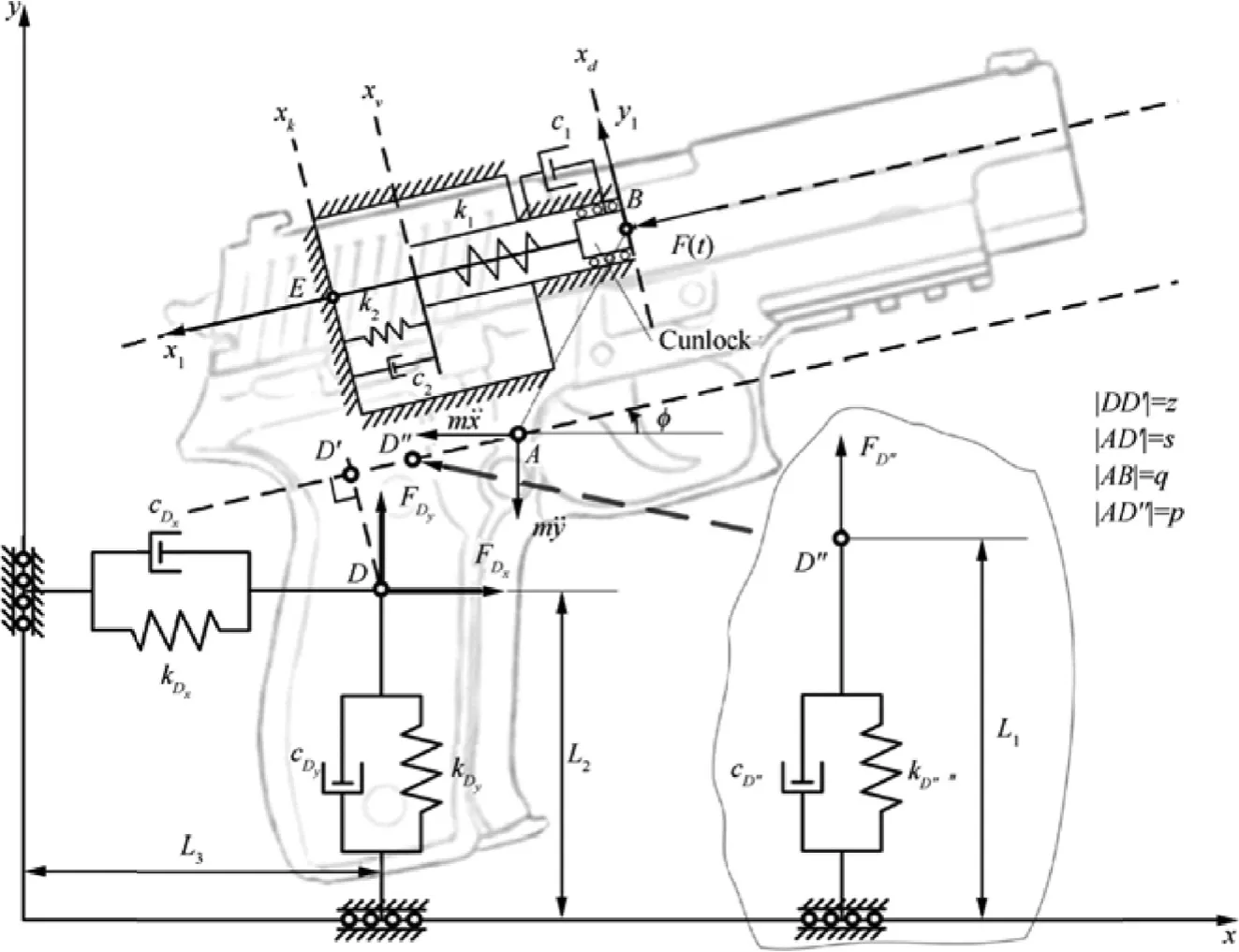


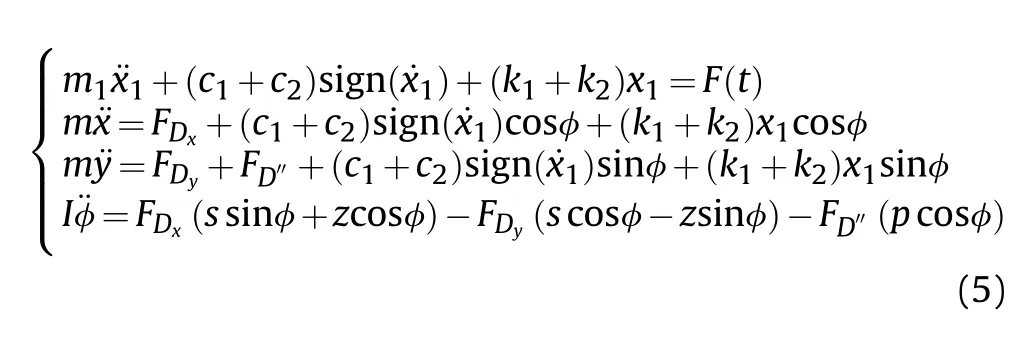


3. Experimental research of the recoil
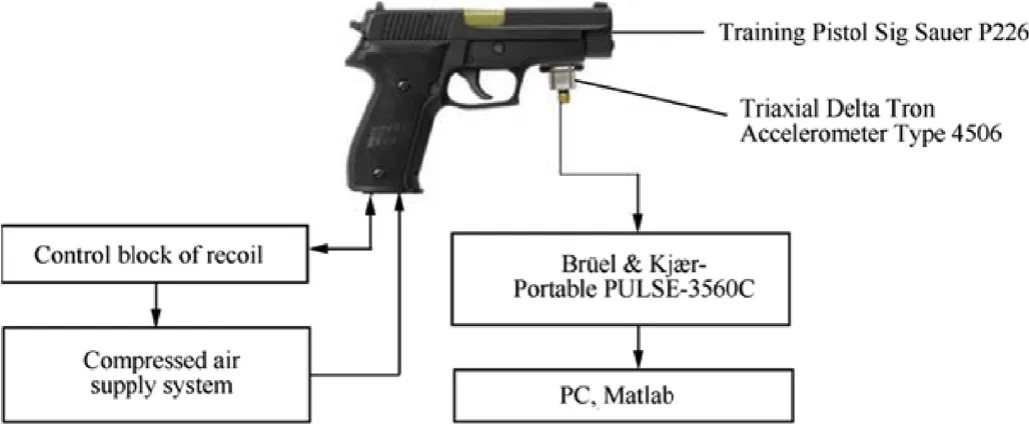
4. New developments in laser training simulators for shooters
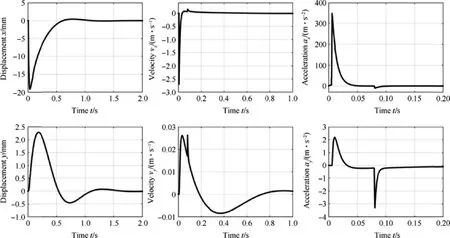
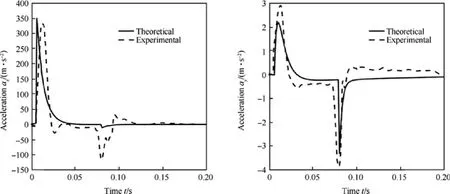
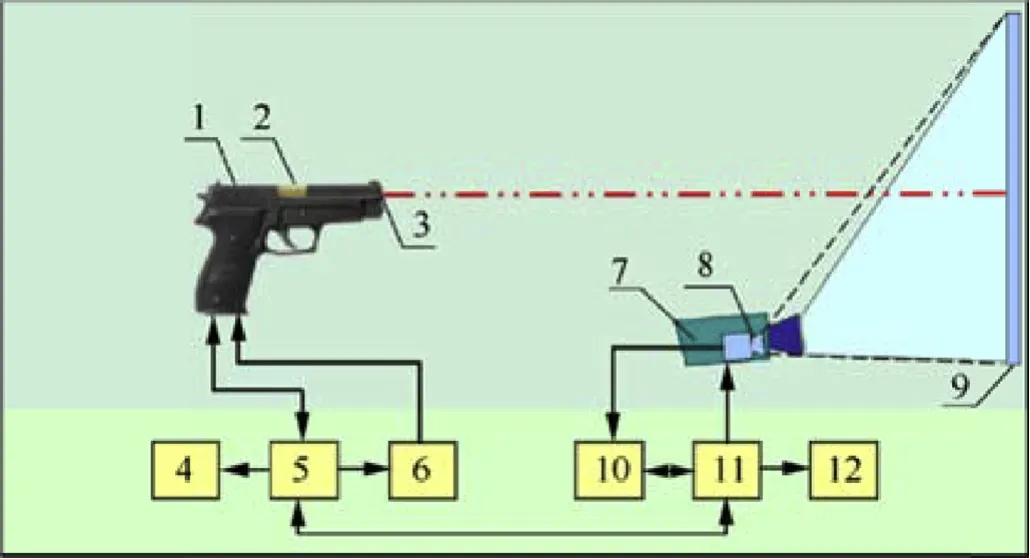
5. Conclusions
Declarations of interest
Acknowledgements
Nomenclature
杂志排行
Defence Technology的其它文章
- Statistical variability and fragility assessment of ballistic perforation of steel plates for 7.62 mm AP ammunition
- Texture evaluation in AZ31/AZ31 multilayer and AZ31/AA5068 laminar composite during accumulative roll bonding
- Local blast wave interaction with tire structure
- Summed volume region selection based three-dimensional automatic target recognition for airborne LIDAR
- A novel noise reduction technique for underwater acoustic signals based on complete ensemble empirical mode decomposition with adaptive noise, minimum mean square variance criterion and least mean square adaptive filter
- Research on extraction and reproduction of deformation camouflage spot based on generative adversarial network model
